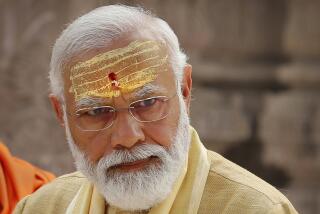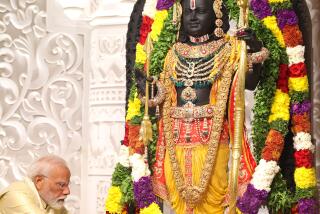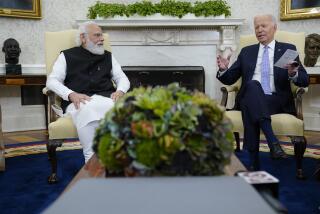India’s Fate : A dynasty ends but the country prevails.
- Share via
NEW YORK — One beautiful Indian morning in November, 1963, just a few miles from the place where Rajiv Gandhi was assassinated on Tuesday, I woke up to learn that the President of the United States, John F. Kennedy, had been shot. It was also in India that I learned of murders in Mississippi and Alabama, riots in Los Angeles and Detroit, the killing of Robert F. Kennedy and Martin Luther King Jr. The news, carried by the Indian press, was of a land torn apart, violent and irrevocably discredited. Yet the United States managed to survive.
Last week brought similarly unsettling news from India, an alteration of silence and high drama for most outsiders who hear of the country only in its desperate hours. Gandhi was not a man of extraordinary talents or vision. His bravery consisted of his quiet commitment to democratic politics--which meant stepping into the opposition when his party lost the 1989 national elections and facing the possibility of assassination when conducting a far-reaching campaign to return to power.
India has had its share of great leaders, but Gandhi wasn’t one of them. He was more significant for his willingness to let the symbolism of history flow through his presence.
Most important in that history was Jawaharlal Nehru, his grandfather, the greatest builder of India’s democratic institutions, its staunch independence and its commitment, however halting, to social justice. Nehru cultivated a broad, cosmopolitan culture, drawing on a family tradition of close ties with both Mughals and British, which he worked to transform into nationalism and representative government.
Gandhi’s father, Firuz, was from a Zoroastrian, not a Hindu, family; his wife--who was offered the job of party leader after his death but refused it--is Italian. Like the Mughals of the 16th and 17th centuries, with their carefully chosen matrimonial alliances, this family background meant Gandhi was of no single religion, region or ethnicity--he was India in general. During the last seven years, he succeeded in personifying India’s rapidly expanding, urban middle class--well-educated, well-connected in ternationally and with a taste for consumer goods. If they could have a country of their own, India’s urban middle class would be one of the largest nations in the world.
Gandhi was also his mother’s son. Indira Gandhi, India’s prime minister for nearly two decades until her own assassination in 1984, did much to destroy the Indian National Congress as the country’s only nationwide party with her inconsistent, sometimes authoritarian and often unscrupulous politics.
Like his mother--and very much unlike his grandfather, Jawaharlal--Gandhi distrusted strong and independent-minded colleagues. As a result, the party he led has virtually no one to take his place--the best having been driven out in favor of a fairly unsavory and mediocre bunch. But it is only in contrast to the greatest of India’s past leaders and its pressing needs that so many of India’s politicians appear tarnished.
Gandhi’s major political opponents at the national level don’t really represent radical alternatives. They rely on the momentum of political opportunity, the search for allies, the persuasive symbol to win votes and retain constituencies. Former Prime Minister V.P. Singh, once a minor raja and later a supporter of Indira Gandhi’s authoritarian interlude, now stands as spokesman for the downtrodden--but not the very downtrodden. He wants to extend affirmative action to groups one notch above untouchability. The political contest is to define as many groups as possible that deserve special treatment and which are then expected to reward their champions with votes.
Opposing this group politics is the Bharatiya Janata Party, often referred to as right wing and Hindu fundamentalist--though by U.S. political standards it could fit comfortably into the Republican Party. The Hinduism of the BJP is theologically and socially without content, a matter of picking the opportune symbol for short-term political advantage--something like George Bush’s dedication to school prayer and the flag. It is a party, though not the only one, that has been willing to foment violence to attract a following, and so frightens many Indians.
The BJP’s real goal, aside from winning office, is to create a culturally uniform India, in opposition to those who see India’s special greatness in its accommodation of diversities of religion, language and other identity markers. But its leaders are canny politicians, ready to make deals and reach compromises.
Movements of culturally defined political separateness, especially when stated in terms of territory, summon up images of the partition of India in 1947, and the creation of Pakistan. In contrast to the model of a united nation-state, India developed territorial boundaries both within, for its linguistically defined states, and without, for its religiously defined neighbors, Pakistan and, after 1971, Bangladesh.
Politicians whose region and language could not aspire to national domination might still find power in demands for decentralization. When those demands were resisted, they could often be pushed further into a call for national independence. Now it is Muslims in Kashmir, Sikhs in Punjab and a variety of ethnicities in the northeastern corner that have been drawn by the central government’s miscalculation and intrigue into full-blown separatism.
Gandhi was assassinated in the southern state of Tamil Nadu, once the home of independent India’s most militant separatist political movement. With the connivance of Indira and Rajiv, this movement developed links to the violent Tamil separatists of northern Sri Lanka, while comfortably holding power within its own Indian state.
If no group has claimed responsibility for the bombing, many had reason. It could have had something to do with India’s intervention in the troubled politics of its small neighbor, Sri Lanka; or with longstanding threats from Sikh terrorists seeking to avenge atrocities allegedly associated with his mother and, after her assassination, with some members of his party, or conceivably with other persons or groups. As with the killing of Gen. Zia ul-Haq of Pakistan in 1988, there is something to be said for not being able to pin the blame, lest it set off a further chain of violence.
This is by no means the first time that India has been swept by violence. Corrupt politicians are nothing new, either. Since independence, if not before, Indians and foreign observers have bemoaned the passing of better days. It is no denial of India’s problems of poverty, illiteracy, group conflict, the threat of war with its neighbors and what borders on civil war in particular regions to also say that India is too big, too diverse, too decentralized and has too much practical political experience among its people to come tumbling down in some final national cataclysm. Parts of it--sections of its population, specific regions, particular sectors of society--will thrive as others suffer. India, as a whole and in most of its parts, can regroup and revive, a stumbling democracy, a tangled bureaucracy.
India’s politicians have the capacity to hammer out deals that will restore some semblance of unity. What stands between the leaders is personal rivalry and intense ambition--not policy or principle--but that can be destructive enough. Temporary conditions, reaching down to local power centers, could reformulate the boundaries of party alliances at the national level.
Perhaps the sense of opportunity, if not urgency, that India’s current crisis has brought about will propel politicians toward a unity government. This is unlikely to be the site of great achievements, but it ought to allow those areas of government that function under the umbrella of national politics to carry on.
The country may well have to do without great leaders and even a clearly defined national political agenda--at least for some time to come. But India is much more than just another nation; it is a major world civilization that will survive this crisis as it has so many before.
More to Read
Sign up for Essential California
The most important California stories and recommendations in your inbox every morning.
You may occasionally receive promotional content from the Los Angeles Times.










